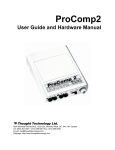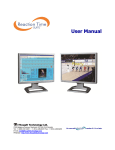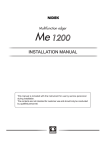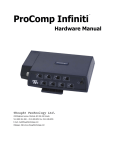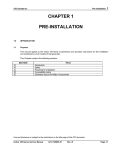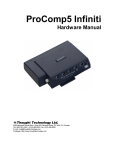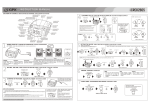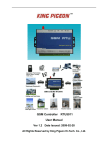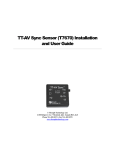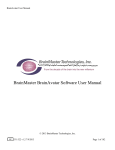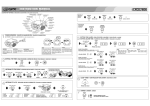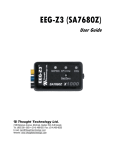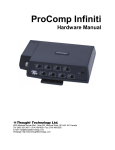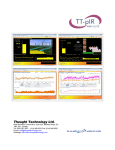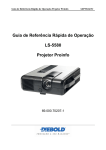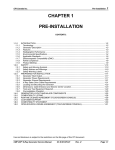Download User Manual - Thought Technology, Ltd.
Transcript
User Manual Thought Technology Ltd. 8205 Montreal/ Toronto Blvd. Suite 223, Montreal West, QC H4X 1N1 Canada Tel: +1 (800) 361-3651 ۰ +1 (514) 489-8251 Fax: +1 (514) 489-8255 E-mail: [email protected] Webpage: http://www.thoughttechnology.com For use w ith version 6.0 or later User Manual CLASSIFICATION • • • Type BF Equipment Internally powered equipment Continuous operation • Read Instruction Manual • US Federal Law restricts this device to sale by or on order of licensed health care practitioners. CAUTION WARNING • Do not operate active sensor within 10 feet (3m) of an operating cellular phone, similar radio transmitting device, other powerful radio interference producing sources such as arc welders, radio thermal treatment equipment, x-ray machines or any other equipment that produces electrical sparks. All encoders are totally isolated from line (110 or 220VAC) power due to battery operation and fiber optic connections to computers. However, many hospitals and the FDA require that computers, printers and any other equipment used with medical devices be electrically isolated from line voltage to UL or CSA medical safety standards. Do not connect inputs or outputs of the encoder or sensors to line powered devices, except through the fiber optic cable. The PC used with the encoder must be placed outside the patient/client environment (more than 3 meters or 10 feet) or the PC must comply with EN60601-1.1 (system safety). After use, the disposable electrodes may be a potential biohazard. Handle and, when applicable, dispose of these materials in accordance with accepted medical practice and any applicable local, state and federal laws and regulations. To diminish the risk of spreading communicable diseases, always use good hygiene practices with reusable EMG electrodes, particularly if abrasive substances are used. In all cases, refer to your facility’s infection control procedure. Do not use in the presence of a flammable anesthetic mixture with air or with Oxygen or Nitrous Oxide. Not to be immersed in water. Take care in arranging patient and sensor cables to avoid risk of patient entanglement or strangulation. The operator is responsible for ensuring the safety of any devices controlled or triggered by Infiniti equipment or software, or by any software or hardware receiving data from Infiniti equipment. Infiniti equipment must not be configured or connected in such a way that failure in its data acquisition, processing or control functions can trigger patient feedback stimulus that poses an unacceptable level of risk. Use of any equipment in a biofeedback context should be immediately terminated upon any sign of treatment-related distress or discomfort. Not to be connected to a patient undergoing MRI, Electro surgery or defibrillation. • • • • • • • • • • • ATTENTION • • • • • • • To prevent static discharge from damaging the sensor and/or encoders, use antistatic mats or sprays in your working area. A humidifier may also be used to help prevent static environments by conditioning hot, dry air. Not for diagnostic purposes. Not defibrillator proof. Not for critical patient monitoring. To prevent voiding warranty by breaking connector pins, carefully align white guiding dot on sensor plug with slot on sensor input. Sharp bends or winding the fiber optic cable in a loop smaller than 4 inches (10cm) may destroy the cable. A fiber optic cable not fully pushed into its receptacle may cause the unit not to operate; make sure that both ends of the cable are fully inserted into their receptive jacks and the nuts are tightened firmly. Make sure to remove electrodes from sensor snaps immediately after use. Apply conductive gel only to electrodes; never put gel directly on sensor snaps. User Manual i • • • • • Always use electrodes between the subject and the sensor. Sharp bends or winding the fiber optic cable in a loop smaller than 4 inches (10cm) may destroy the cable. A fiber optic cable not fully pushed into its receptacle may cause the unit not to operate; make sure that both ends of the cable are fully inserted into their receptive jacks and the nut is tightened firmly. Do not plug third party sensors directly into instrument inputs. Plug only Thought Technology active sensor cable connectors into instrument inputs. All EMG electrodes and third party sensors must be connected to active sensors, either directly or through an adapter. Remove batteries when the device is not being used for extended period of time. Please dispose of battery following national regulations. INTENDED PURPOSE • Biofeedback, relaxation and muscle reeducation purposes. CONTRAINDICATIONS • Patients with limited or impaired physical and mental capacity NOTE • • • • • No preventative inspections required; maintenance must be performed by qualified personnel. The supplier will make available, upon request, circuit diagrams, component parts lists and description or other information required for the repair of product by qualified personnel. If a fiber optic or patient cable is damaged or breaks, please replace it. Due to the essential performance and intended use of the device, testing for immunity to electromagnetic disturbances was not required and was not performed. The device may be susceptible at levels below IEC60601-1-2 immunity test levels. The operator must be familiar with typical characteristics of signals acquired by this equipment, and be able to detect anomalies in the acquired signal that could interfere with treatment effectiveness. Depending on the importance of signal integrity, it may be advisable to continuously monitor the raw signals, in time and/or frequency domain, while the device is being used for biofeedback or other purposes. If anomalies are observed on acquired signals, and if you suspect a problem with electromagnetic interference, contact Thought Technology for a technical note on identification and remediation. MAINTENANCE AND CALIBRATION • Wipe encoder with a clean cloth. • Factory testing and calibration ensure equipment accuracy and frequency response. The user may invoke a self-calibration function that will recalibrate certain device parameters (see section in hardware manual). Contact Thought Technology for factory recalibration if necessary. STORAGE • • • • Store in its original case. Temperature Humidity (Non-condensing) Atmospheric Pressure TRANSPORTATION • Transport in its original case. • Temperature • Humidity (Non-condensing) • Atmospheric Pressure User Manual -23 to +60C (-9.5 to 140F) 10% to 90% 70 to 106 Kpa -23 to +60C (-9.5 to 140F) 10% to 90% 70 to 106 Kpa ii Guidance and manufacturer’s declaration - electromagnetic emissions The Infiniti system is intended for use in the electromagnetic environment specified below. The customer or the user of the Infiniti system should assure that it is used in such an environment. Emissions test Compliance Electromagnetic environment - guidance The Infiniti system uses RF energy only for its RF emissions internal function. Therefore, its RF emissions are Group 1 CISPR 11 very low and are not likely to cause any interference in nearby electronic equipment. RF emissions Class B The Infiniti system is suitable for use in all CISPR 11 establishments, including domestic establishments Harmonic emissions Not applicable and those directly connected to the public lowIEC 61000-3-2 voltage power supply network that supplies Voltage fluctuations/flicker emissions buildings used for domestic purposes. Not applicable IEC 61000-3-3 Manual No. SA7966 Revision 6.0 User Manual iii TABLE OF CONTENTS Introduction ........................................................................................................................ 1 Installation and System Requirements ..................................................................................... 2 Before You Begin ...................................................................................................................................................................2 Requirements .........................................................................................................................................................................2 First Time Run ..................................................................................................................... 3 Starting the Program .............................................................................................................................................................3 Entering Key Codes ...............................................................................................................................................................4 Hardware Setup .................................................................................................................. 6 The Encoder ...........................................................................................................................................................................6 Connecting TT-USB and the encoder ....................................................................................................................................... 6 Battery placement ..................................................................................................................................................................... 7 Caring for the fiber optic cable .................................................................................................................................................. 7 Electromagnetic electrical interference...................................................................................................................................... 8 Sensors and Accessories .....................................................................................................................................................8 Electromagnetic interferences ................................................................................................................................................... 8 Electrostatic discharges ............................................................................................................................................................ 8 Connecting the sensors ............................................................................................................................................................ 8 Correct orientation of sensors ................................................................................................................................................... 9 EEG-Z Sensor (P/N: SA9305M) ................................................................................................................................................ 9 Connecting and placing EEG-Z sensors.................................................................................................................................. 10 10-20 electrode placement system.......................................................................................................................................... 10 EEG electrodes....................................................................................................................................................................... 10 EEG electrode placement technique: ...................................................................................................................................... 13 Software Overview .............................................................................................................. 18 Client Database ....................................................................................................................................................................18 Recording Sessions ............................................................................................................................................................18 Start the program .................................................................................................................................................................... 18 Starting a session from a Favorite........................................................................................................................................... 19 Starting a script session .......................................................................................................................................................... 19 Starting an open display session............................................................................................................................................. 21 Sensor connections ................................................................................................................................................................ 22 Stopping a Session ..............................................................................................................................................................22 Replaying Sessions .............................................................................................................................................................24 Reviewing Sessions ............................................................................................................................................................24 Rejecting artifacts ................................................................................................................................................................... 25 Calculating statistics ............................................................................................................................................................... 27 Generating session reports ..................................................................................................................................................... 28 Tool Bar Options ..................................................................................................................................................................30 Toggling between screens ...................................................................................................................................................... 30 Adjusting scales and threshold................................................................................................................................................ 30 Impedance Check ................................................................................................................................................................30 ProComp Infiniti, ProComp5 Infiniti, and FlexComp Infiniti encoder ......................................................................................... 30 ProComp2 encoder ................................................................................................................................................................. 31 Impedance Check window ...................................................................................................................................................... 32 User Manual iv Z-Score Assessment and Training........................................................................................... 33 Overview ...............................................................................................................................................................................33 Z-Score Screen Instrument .................................................................................................................................................34 Interpreting the Z-Score instrument ......................................................................................................................................... 35 Right-click menu options ......................................................................................................................................................... 35 General Procedure ...............................................................................................................................................................36 Starting a session ................................................................................................................................................................... 36 Verifying channel settings ....................................................................................................................................................... 36 Suggested Usage Scenarios ...............................................................................................................................................39 Assessment ............................................................................................................................................................................ 39 Training .................................................................................................................................................................................. 40 Reviewing/Reporting ............................................................................................................................................................... 41 Screens .................................................................................................................................................................................41 Scripts...................................................................................................................................................................................41 Open Session Assessment .................................................................................................................................................43 Artifact calibration screen ........................................................................................................................................................ 44 Assessment screens ............................................................................................................................................................... 44 Training.................................................................................................................................................................................45 Training screens ..................................................................................................................................................................... 46 Reporting ..............................................................................................................................................................................49 Report screens ....................................................................................................................................................................... 50 Specifications and Support ................................................................................................... 52 Hardware Specifications .....................................................................................................................................................52 Placing Orders .....................................................................................................................................................................52 Technical Support ................................................................................................................................................................52 Warranty ...............................................................................................................................................................................53 Returning Equipment for Repair .........................................................................................................................................53 Repair Return Form .............................................................................................................................................................54 User Manual v User Manual Introduction Welcome to the user manual for Z-score 6 suite. This manual provides information intended to help you get the most out of your system. The manual is organized into chapters as follows: • Installation and System Requirements lists the computer and software requirements recommended for running the BioGraph Infiniti software and the Z-score 6 suite. • First Time Run explains how to start the software and verify its settings prior to using it for the first time. • Hardware Setup provides general information about the encoder, sensors and accessories included with the system. It also shows how to connect the hardware elements. • Software Overview introduces the main functions of the BioGraph Infiniti software: recording, replaying, and reviewing sessions. It discusses the analytical processes of impedance checking, artifact rejection, statistics calculation, and report generation. • Z-Score Assessment and Training introduces the concept of z-score biofeedback and provides details about each of the components of the suite, including scripts, screens and Quick Start favorites. It includes a description of the Z-score instrument, new in BioGraph Infiniti 6.0. The remaining sections of the manual provide a list of Hardware Specifications, and information about the Warranty, obtaining Technical Support, and Returning Equipment for repair if necessary. Note: Important safety information about operating the equipment is provided in the front matter of the manual starting on page i. User Manual 1 Installation and System Requirements Before You Begin There are three software products you will need to fully benefit from z-score biofeedback assessment and training. These are BioGraph Infiniti version 6.0, the latest Z-Score 6 Suite, and the Z-Score Biofeedback Add-on. • BioGraph Infiniti version 6.0 is the main software engine of all Thought Technology Ltd systems. It must be installed first. • Z-Score 6 Suite provides the computations, screens and scripts required for z-score assessment and training. • The Z-Score Biofeedback Add-on contains the NeuroGuide Z-Score functionality from Applied NeuroScience Inc., and requires a key code license to fully install and operate. The z-score biofeedback computations can be accessed, screens can be loaded, and sessions can even be recorded and reviewed, but no z-score values will be displayed until the Z-Score Biofeedback Add-on is installed and the key code is entered. For more information, check the FAQ section of the Thought Technology website or contact our Technical Support. Requirements Please refer to IS7915 – BioGraph Infiniti PC System Requirements for a detailed list of requirements for running BioGraph Infiniti 6.0. User Manual 2 First Time Run Once the software is installed, you have to configure your system. This takes only a few minutes. Starting the Program To start the program, simply double-click on the BioGraph Infiniti icon on the Desktop. The program always starts by showing the Main Menu screen. From here you can set global settings that affect the performance of BioGraph Infiniti. Note: Global settings remain in effect unless you change them. Notch Filter A notch filter removes the specific frequency caused by electrical interference from a raw signal. The signals that are susceptible to electrical interference are EEG, EKG and raw EMG. Notch filter settings affect all signals of the selected type and work with any channel set. Select Preferences from the Tools menu in the Main Menu Screen. In Notch Filters, select the EEG Signal type and set Frequency to 50Hz or 60Hz, depending on the transmission frequency used in your country (60Hz for North America, for instance). Then click OK. User Manual 3 Confidential Setting Optionally, enable the Confidential setting. This helps protect the privacy of your clients by masking their names in the client database. • Click Database to open the Main Database window. • From the Settings menu, select Confidential. The check mark indicates that the setting is enabled. • If you need to disable the Confidential setting, repeat these steps to remove the check mark. With the Confidential setting disabled With the Confidential setting enabled Entering Key Codes The first time you start to record a session with BioGraph Infiniti, the software will check for the key codes and ask you to enter them. There are three ways to start recording a session. They are described fully in the chapter Software Overview beginning on page 18. • Quick Start: Click this option to record a Favorite session (page 19). This is the preferred method for recording sessions. • Start Open Display Session: Click this option to record an unscripted session using your own selection of feedback screens (page 21). • Start Script Session: Click this option to record a script session (page 19). 1. Click Quick Start, select a name from the Clients list and a protocol from the Favorites list, and then click OK. 2. The Encoder Key Codes dialog box opens. 3. Click to highlight your unit’s serial number in the left table (in this example, DA1002; this is the same number as on the back of the unit). The serial number is found on the back of the encoder. 4. Enter the Encoder Key Code (found inside the encoder battery compartment) in the Key Code text box. 5. to move the serial number from the left table to the right table. The serial number should now Click appear in the Configuration Table. 6. When done, click OK. User Manual 4 7. Now the Application Key Code dialog box opens. 8. Enter the Application Key Code. This number is found in the battery compartment with the encoder key code. 9. When done, click OK. Note: Even if you are using more than one encoder, you need to enter only one Application Key Code. If the key codes have been entered properly and there is no problem with your encoder setup or your sensor connections, the recording screen will open. User Manual 5 Hardware Setup Before you can start recording a session, you have to set up your hardware. The following section describes how to connect a FlexComp Infiniti encoder but the process is similar when using other encoders. For more information on using your particular encoder, please refer to the device’s hardware manual. The Encoder Connecting TT-USB and the encoder Unconnected hardware components Insert one end of the fiber optic cable carefully into the fiber optic port on the encoder. Tighten the nut gently so that the cable won't slip out. Do the same with the other end of the fiber optic cable and the fiber optic port of the TTUSB interface unit. Insert the small connector of the USB cable into the USB port on the TT-USB interface device. Insert the large connector of the USB cable into the USB port of your PC. User Manual 6 Connected hardware components USB ports on a PC are generally located at the back of the base unit. You may also find a USB port at the front of your base unit; you can connect the other end of the USB cable to it. On a laptop, USB ports are usually located at the side or the back of the laptop. It is recommended to always use the same USB port for connecting the TT-USB to your computer. Battery placement Opening the compartment Looking at the underside of the encoder, you will see a long door in the plastic enclosure. Holding the encoder with the connectors facing you and with the door up, push lightly down and back with your thumbs on the door to slide it open. Attention: The internal workings of the encoder are not intended to be opened for repair except by qualified service personnel. The tamper-evident seal under the batteries in the battery compartment should not be removed or broken. Thought Technology may refuse to honor the unit’s warranty if the seal is broken. Polarity When the compartment cover has been slid out, place four AA batteries in the slots, observing the correct battery polarity as embossed on the inside surface of the compartment. Closing the compartment Slide the door back into the encoder case, gently pushing it in until you feel the click of the locking mechanism. Keeping an eye on the battery level Since each sensor draws a small amount of power from the batteries when connected to the encoder, it is better to connect only the sensors that are going to be used for a session before you start recording; this will ensure maximal battery life. Most Thought Technology software applications will display a battery power indicator; we recommend that you replace the batteries as soon as this indicator falls below about 50% of the battery power. Caring for the fiber optic cable A fiber optic (FO) cable is used for transmitting the sensor data to the computer. Although this technology provides maximal electrical isolation, signal fidelity and freedom of movement, some care has to be taken when handling the fiber optic cable, as it is much less flexible than a regular electric wire. Be careful not to bend it sharply or wind it in a loop smaller than 4 inches in diameter. User Manual 7 Electromagnetic electrical interference When performing a biofeedback session, it is best to avoid placing the encoder near the computer, display monitor or any other electrical device, where it can be exposed to electromagnetic fields. Sensors and Accessories The instrumentation system includes a group of sensors used for the various protocols. Before a session can be recorded, the correct sensors must be connected to the encoder. Electromagnetic interferences The EEG sensors are capable of detecting very tiny electrical signals (millionths of a Volt) generated by muscle activity. Therefore they are very sensitive to electromagnetic fields generated by other devices in the exam room, such as radio transmitting devices, computer monitors, medical devices (for example x-ray machines), and fluorescent, halogen or neon lights. These devices should be turned off, if they are not needed for the examination. If the situation arises, keep the instrumentation 10 feet away from radio transmitting devices and 3 feet away from electronic devices (including monitors) and fluorescent, halogen or neon lights. Disconnect all the unused sensors from the encoder. If not connected to the examinee, they may act as antennas and capture unwanted signals that would corrupt the signal being recorded. Electrostatic discharges To prevent static discharge from damaging the sensor and/or encoder, use antistatic mats or sprays in your working area. A humidifier may also be used to help prevent static environments by conditioning hot, dry air. Connecting the sensors When connecting a sensor to the encoder, make sure to properly line up the guiding dot on the top of the plug with the notch in the device's input socket. Guiding dot Notch Forcing the plug into the jack in any other position may damage your equipment. User Manual 8 Correct orientation of sensors The EEG Flex/Pro and EEG-Z sensors have removable cables and two input entrances. It is important to orient these sensors to the encoder correctly so that the physiological signal is properly received. Connect to electrodes The EEG sensor is correctly oriented to the encoder when the cable joining them is connected to the bottom entrance of the sensor. The extender cable with electrodes should be connected to the top entrance of the EEG sensor. Connect to encoder EEG-Z Sensor (P/N: SA9305M) The following is an overview of the EEG sensors and electrodes used with the system for Z-score assessment and training. The EEG-Z is a preamplified electroencephalograph sensor with built in impedance sensing capabilities. This sensor can be toggled to record regular EEG or monitor skin impedance (both the reactive and resistive elements) to help optimize electrode hookup. Used for: • Assessment • EEG biofeedback Note: The EEG Flex/Pro sensor can also be used with this suite but the EEG-Z is recommended because of its ability to measure impedance. Each EEG-Z sensor comes with a monopolar/bipolar electrode kit (shown). Other electrode kits are also available separately. Note: To perform 2-channel and 4-channel Z-score biofeedback most efficiently, the multi-channel connectivity kits are recommended (T8760: 2-channel connectivity kit; T8761: 4-channel connectivity kit). These kits also include the necessary cables for linked ears reference, which is required for z-score biofeedback. Monopolar/bipolar electrode kit (T8750) User Manual 9 Connecting and placing EEG-Z sensors 10-20 electrode placement system The ten-twenty (10-20) electrode system of the International Federation is the standard for electrode placement. It is used to place surface EEG electrodes in a repeatable way independent of inter-patient anatomical variability. Called 10-20 because of the way distances between electrode sites are computed. The distances between certain anatomical landmarks are segmented at increments of 10% and 20% of their value, and electrodes are placed at these points. A letter is used to indicate over which area of the brain the site is located. Sites are identified as follows: Frontal lobe - F Central sulcus - C Parietal lobe - P Frontopolar area - FP Temporal lobe - T Occipital lobe - O Other miscellaneous labels are used for the ears (A) and other reference sites (for example, M for mastoid process, G for ground, etc.). The letter Z indicates the central line along the interhemispheric fissure. Numbers are used to indicate the position in reference to the central line (Z). Number value increases the further away a site is from the central line. Odd numbers are on the left. Even numbers are on the right For example, along the line joining sites A1 and A2: to the right of A1, at 10% of the overall A1-A2 distance is electrode site T3. This is followed by C3 (20% further), Cz (20% further), C4 (20% further), and T4 (20% further). Site T4 should fall 10% to the left of A2. EEG electrodes As mentioned above, each EEG-Z sensor comes with a monopolar/bipolar electrode kit. The kit is composed of the following components: T8750 electrode kit DIN cable Color coded inputs Color coded cup electrodes Color coded earclips User Manual 10 Instructions for 1-channel EEG: Connect the blue active electrode to the blue DIN cable input. DIN cable Connect the yellow ear clip to the yellow DIN cable input, and the black earclip to the black DIN cable input. The other end of the DIN cable plugs into the input of the EEG-Z sensor. Note: EEG-Z sensor Electrode cables The yellow cup electrode can replace the yellow ear clip for bipolar placement. For two channel applications, using two EEG-Z sensors simultaneously, the 2-channel connectivity kit is used. T8760 2-channel connectivity kit Y-splitters needed for 2-channel placement Extra cables used for linked ear reference Instructions for 2-channel EEG: Using two T8750 packages, start by connecting the blue active leads to the blue sockets in the DIN cables. Take 1 y-splitter of each type from the T8760 package. Connect the single output connector of B to the single electrode connector of A. Note: 1M2F y-splitter (A) There are two of A in the kit, and only one of B. Connect a yellow earclip to each electrode connector of B. The completed linked-ears reference is shown below. 2M1F y-splitter (B) User Manual 11 B A Connect the output connectors of A to the yellow inputs in the DIN cables as indicated. Connect the black earclip to the single electrode connector of the remaining y-splitter (same as A, above). Connect the output connectors of the y-splitter to the black inputs in the DIN cables, as was done for the linked-ear reference. Final result: Two linked yellow earclips are connected to the yellow input of both sensors, a single black earclip is connected to the black input of both sensors, and individual blue cup electrodes are connected to their respective blue input on each sensor. Instructions for 4-channel EEG: The four-channel configuration is essentially the same as the two-channel configuration described above. The main difference is that a 4-channel splitter (provided in the 4-channel connectivity kit, T8761) is used in place of the 2-channel splitters described above. Using four T8750 packages, start by connecting the blue active leads to the blue sockets in the DIN cables. Take 1 y-splitter of each type from the T8761 package. Connect the single output connector of B to the single electrode connector of C. User Manual 1M4F y-splitter (C) 12 Note: There are two of C in the kit, and only one of B. Connect a yellow earclip to each electrode connector of B. 2M1F y-splitter (B) Connect the output connectors of C to the yellow inputs in the DIN cables. Connect the black earclip to the single electrode connector of the remaining y-splitter (same as C, above). Connect the output connectors of the y-splitter to the black inputs in the DIN cables, as was done for the linked-ear reference. Final result: Two linked yellow earclips are connected to the yellow input of four sensors, a single black earclip is connected to the black input of four sensors, and individual blue cup electrodes are connected to their respective blue input on each sensor. EEG electrode placement technique: Proper site preparation and electrode placement are essential for clean, trouble-free recording of the EEG signal. The following steps describe how to achieve a secure connection in an efficient, repeatable way. They should be followed closely every time EEG is recorded. This may seem daunting at first, but the technique is easily learned and the user will quickly become accustomed to it and will certainly appreciate the benefits. Locate the required electrode site(s) For 1-channel EEG biofeedback protocols, a common site to use is CZ. This site is located, prepared and fixed with an electrode in the example below. For 2-channel protocols, there will be two electrode sites, for example, C3 on the left and C4 on the right, also shown below. Similarly, 4-channel protocols require placement of electrodes at four sites. The actual electrode locations to be used will depend upon the z-scores being assessed and trained. Locate the inion. On the posterior base of the skull, where the spine meets the skull, there is a small protrusion called the “inion”. It can be found by running the finger up the spine towards the skull. There is a small crevice between the spine and skull in which vertebrae can no longer be felt. Just above that area, the inion of the skull can be found. Locate the nasion. The depression on the bridge of the nose, just below the brow and directly between both eyes, is called the “nasion”. User Manual 13 The line between these two points runs along the interhemispheric fissure of the brain (the space that separates the left and right sides of the brain, i.e. right down the middle). Mark a spot located at 50% of the distance between the nasion and the inion. 50% Locate the mandibular notch. Anatomy revisited: To locate the mandibular notch, place a finger against the tragus, just anterior to the ear, and ask the subject to open their mouth. Your finger should find its way into a cavity, resting superior to the mandibular notch. tragus Find this spot on both sides of the head. The line that connects the left and right mandibular notches runs along the central sulcus of the brain (the space that separates the frontal and parietal lobes). Mark a spot located at 50% of the distance between the left and right mandibular notches. It should intersect directly with the mark made between the front and back of the head. The intersection of these two lines is electrode location CZ, also sometimes referred to as the vertex. Along the line between the mandibular notches, 20% of the total distance towards the left is location C3, 20% towards the right is location C4, for example. The remaining sites are found in a similar way. User Manual 14 Note: Electrode location CZ can always be approximated instead of explicitly measured following the procedure described above. It is the top middle of the skull. Imagine if the subject were to hang perfectly straight from a string tied to the top of their heads, this is where the string would have to be fixed. The other sites described in the above example, C3 and C4, can simply be estimated to be a certain distance away from that top middle point towards the left and right ears, respectively. Still, to ensure repeatable measurements, especially when comparing across sessions, it is recommended that the electrode locations be explicitly measured as described. Prepare the scalp The scalp must be prepared before an electrode can be fixed. This involves slightly abrading the skin to remove dead skin, sweat and other contaminants to the EEG signal. The following steps should be followed for all electrode location sites. Scoop up a small quantity of NuPrep ™ skin prepping gel on a cotton swab or tissue. With the thumb and index finger of one hand, separate the hair around the electrode site that was previously found and marked. Run the gel in the direction of the natural line formed along the scalp by the split hair. Some light force must be used, enough to redden the scalp slightly, but not enough to break the skin. User Manual 15 Wipe away the excess prepping gel with a dry, lint-free cloth. Care should be taken to keep the hair parted and to keep track of the site after wiping clean. Helpful trick: A small amount of Ten20™ Conductive paste should be smeared on the newly prepared site. This has the combined effect of keeping track of the site, keeping the hair neatly out of the way, and acting as a landing pad for the electrode once it is ready to fix. Prepare the electrodes Start by securing the electrode cables to the patient. Helpful trick: Loop the three electrode cables around the plastic clip provided with the EEG-Z sensor. Attach the clip to the back of the shirt collar as shown below. Keep the heavy DIN cable and EEG-Z sensor underneath the clip, and the light electrode cables above it. Electrode cables Plastic clip, set at a 90 degree angle for best placement DIN cable (attached to EEG-Z sensor – not shown) Fill the electrode cup with Ten20 ™ conductive paste so that no air bubbles exist in the cup. Add more Ten20 paste onto the cup electrode, just enough to form a ball on the cup, not so much that it spills over the edge. Shown is the ideal amount of paste. Place the cup face down on the landing pad previously prepared. Gently push the electrode down to fix it to the scalp. A little bit of paste should run out along the edge of the cup to form a thin ring around it. Helpful trick: Place the electrode so that the direction of the cable does not place undue stress on the cup (so that it gets pulled, lifted or twisted off). The cable should hang naturally and towards the plastic clip (as shown). Leave enough slack in the cable to allow for comfortable head movement as well. User Manual 16 Reference sites Repeat the above preparation and placement steps on the ear lobes. Do not put too much paste on the ear clip electrode, but ensure that the gold disc is completely covered. Leave enough slack in the cable to allow the patient to turn their head easily, but not too much that it can get caught. Think about the angle of the cable from the ear clip to the neck clip, so that no extra tension is placed on the ear clip. Viewed from behind, the final configuration should look similar to this. A single channel setup is shown for clarity. Note the position of the clip, the direction of the cables and the slack left to provide mobility. For two- and four-channel setups, use a separate clip for each channel, and for maximum stability, attach the clip just above the sensor. User Manual 17 Software Overview This chapter provides you with a rapid overview of the main functions of the BioGraph Infiniti software. Refer to the on-line help manual for a more detailed description of all the functions and features of the program. To open the on-line help, press the F1 function key, on your keyboard, from any dialog box in the program. Because the on-line help manual is designed to provide contextual information, it will automatically open at the section that discusses the dialog box from which the help was called. The information in this chapter is of a general nature. Each protocol chapter explains how to record, review and report upon data using that particular protocol. Client Database The Z-score 6 suite requires the client's date of birth in order to correctly compute z-scores. You may need to add this information to existing client files, and you must include it when you create new ones. If the client's date of birth is missing, when you try to record a session, you will get an error message. You will have to modify the client file before you can proceed. Client files are created or modified from the Main Database window. You open this window by clicking the Database button in the main menu screen. 1. To create a new client file, click Add New Client. This opens the Client Data screen where you enter information about the client. Minimum required information is the client's First Name, Last Name and Date of Birth. 2. To modify an existing client file, select the name of the client from the Clients list and click Edit Client Data. This opens the Client Data screen so you can add the client's date of birth to the information already in the file. Recording Sessions With the BioGraph Infiniti software, two types of sessions can be recorded: Open Display and Script sessions. Both types of session can be recorded with BioGraph Infiniti. • Scripts are predefined protocols that group together varied types of activities with specific display screens. They are used for evaluation and assessments because they produce statistics that can be used to determine the type of exercise and/or practice that is needed by the patient. These statistics can be trended across sessions to reflect patient progress. • Open Display sessions are used for biofeedback training, when flexibility is important and you need to be able to rapidly change the session parameters, depending on the client's reactions. The kinds of feedback include various types of audio, such as music, tones, sounds and voice prompts. There are also visual media, such as animations, and different graphs that change color when the signals pass their threshold markers. Start the program After making the necessary connections described in the previous chapter, turn on your encoder and start the BioGraph Infiniti software. User Manual 18 Starting a session from a Favorite A Favorite is a predefined session configuration that contains all the settings you need for recording, replaying, and reviewing a session. Depending on the session type (script or open display), these settings include scripts, channel sets and screens, statistics for session reports, auto-rejection settings for review mode, and Excel report options. Favorites simplify and standardize the process of recording and reviewing sessions. The Z-score 6 suite includes a Favorite for every protocol. You find them listed in the Favorites table when you click the Quick Start button on the main BioGraph screen. To start a session from a Favorite: 1. Click the Quick Start button on the main screen. 2. Optionally, click Add New Client, in the Client Data screen enter at least the person's first and last name, and click OK. 3. Select a name from the list of Clients. 4. Choose Z-score 6 - ProComp Infiniti (or another encoder) from the Categories list. Only favorites belonging to the selected category will display. 5. Select a Favorite from the list. 6. Click OK. If there is no problem with your encoder or sensor connection, the recording screen will open. Note: 7. If this is the first time you are recording a session, at this point the system will prompt you to enter key codes. See page 4 for more details. Start recording by clicking on the Start button in the toolbar. Starting a script session Select Start Script Session from the Main Menu screen. This opens the Start Session screen where you go through the process of selecting a client file and script, setting up session parameters, and launching recording mode. Start Session To record with a new script: 1. Select an existing Client. 2. Optionally, select a previously recorded script session from the Sessions list. 3. Click one of the following New Script options: User Manual 19 • Define New Session to select a new script. • Keep Virtual Channel Settings. Select New Script to keep the client's channel set and settings but select a different script. The Script Database window opens. Script Database To see thumbnail images of the screens used in the chosen script, select Picture View. 4. Select ProComp Infiniti (for Procomp5 and ProComp Infiniti) or Legacy (for ProComp2 encoder) as the encoder communication protocol from the drop-down list at the top. 5. Optionally, select a Z-score 6 category from the Script Categories drop-down list. Only the scripts belonging to the category will display. 6. Select a script from the list, and click OK. Note: 7. If this is the first time you are recording a session, at this point the system will prompt you to enter key codes. See page 4 for more details. When the recording screen opens, start the script by clicking on the Start button instructions. , and follow the on-screen To record with a previously recorded script: 1. Select an existing Client. 2. Select a previously recorded script session from the Sessions list. 3. Click one of the following Start options: • Start to rapidly start a new session with the same display screens and script settings as the selected session. These include any changes you made to the client settings. • Start: Default Settings to start a new session with the default channel set settings instead of any changes you made to the client settings for the selected session. Note: 4. If this is the first time you are recording a session, at this point the system will prompt you to enter key codes. See page 4 for more details. When the recording screen opens, start the script by clicking on the Start button instructions. , and follow the on-screen To record with a new client: 1. Click Add New Client, in the Client Data screen enter at least the person's first name, last name, and date of birth (required for Z-score biofeedback), and click OK. 2. Select the new Client from the list. User Manual 20 3. Click Define New Session and when the Script Database opens, follow the remaining steps to record with a new script. Starting an open display session Select Start Open Display Session from the Main Menu screen. This opens the Start Session screen where you go through the process of selecting a client file and channel set, setting up session parameters, and launching recording mode. Start Session To record a new session: 1. Create a new client as described above, or select an existing client from the list. 2. Select Define New Session to open the window. The Select up to 5 Screens for Open Display Mode window opens. Select up to 5 Screens for Open Display Mode To see thumbnail images of the screens available for the chosen channel set, select Picture View. 3. Select ProComp Infiniti (for Procomp5 and ProComp Infiniti) or Legacy (for ProComp2 encoder) as the encoder communication protocol from the drop-down list at the top. 4. Optionally, select a Z-score 6 category from the Channel Set Category dropdown list. Only the channel sets belonging to the category will display. 5. Highlight a Channel Set on the left. User Manual 21 6. Optionally, choose a Screen Category from the drop-down list. Only the screens belonging to the category will display. 7. Choose one to five Screens from the list, and click OK. To select more than one screen, press down the CTRL key while clicking with the left mouse button. Note: 8. If this is the first time you are recording a session, at this point the system will prompt you to enter key codes. See page 4 for more details. When the recording screen opens, start recording by clicking on the Start button . Sensor connections If there are problems with your sensor connections, the program will report them prior to accessing the recording screen. If, for example, you have sensors that are connected but are not required for this channel set, you will get a warning message. You can remove the sensor if you want, or continue recording by clicking Yes. Keep in mind that no data is recorded for sensors that are not defined in the channel set. Note: If there are sensor connection problems in addition to extra sensors, this information won't appear as a separate message. It will display in the Sensor Connections window. If you have connected wrong sensor types, you will see the Sensor Connections window. All the sensors that are expected will be listed in the Expected Sensor column. The Wrong Sensor Type column shows which sensor type was actually detected. You can remove the wrong sensor or replace it with the right one. Click Repeat to check the sensor connections again until the system no longer detects a wrong sensor type. The program will not allow you to record a session with the wrong sensors. Note: If the Wrong Sensor Type column is empty, the correct sensor has been connected. If you do not connect all the sensors that are required for the selected channel set, the message "Sensor is not detected" appears in the Wrong Sensor Type column. When a sensor is not connected, the program replaces its signal value by a constant value of 1. You can record a session when some sensors are missing, but the corresponding signal will be a flat line. Any calculations based on that signal will not reflect real physiological changes. Stopping a Session No duration is set for an Open Display session. It must be stopped manually by clicking the Stop button . The duration of a Script session is set at the time the script is defined. When the script reaches its end, recording will automatically stop. When the session ends, the following series of message prompts will appear and guide you through the process of saving data, adding notes to the session file, and, optionally reviewing the data or recording another session. User Manual 22 1. Save session data: You can save the session in compressed format but, unless your hard drive has very little space available or you do not need to review the saved sessions, we recommend that you always Save, which uses noncompressed format. Compressed files can’t be replayed, reviewed or trended until they have been decompressed. 2. Enter Session Notes: Here you can enter, if you want, a treatment code, a session description and some notes. Click OK to continue. 3. Review or replay the session: You have the option to analyze the session data at this point. You can switch to review mode or replay mode. After you review the data and close the viewing screen, the program displays the next message prompt. 4. 5. Record another session with the same settings: • If you selected No at the previous message, the program asks if you want to record another session with the same settings. • If you select Yes at this point, the recording screen will reopen. Turn off your encoder: If you selected No at the previous message, the program prompts you to turn your encoder off. Click OK to return to the Main Menu screen. You can also manually stop recording a script session by clicking the Stop button . In this case, you are prompted to confirm the command. • If you select No, the script continues recording normally. • If you select Yes, no data is saved for the session, and you are prompted to record another session with the same settings (message 4, above). User Manual 23 Replaying Sessions Replaying a session allows you to play back a recorded session like a movie. This is useful if you have recorded video data. You can replay the session from any point in time and skip to event markers or script activities and steps. 1. Select Database from the Main Menu screen. 2. In the Main Database window select the client whose session you want to replay. 3. Select the session from the right-hand table. 4. Click on Replay Session at the bottom. Main Database 5. The next step depends on whether you selected a Script session or an Open Display session to replay. • If you selected a Script session, the main frame screen opens in replaying mode. • If you selected an Open Display session, the window Review/Replay Session Confirmation opens. To replay the session using different screens from those used to record it, click Select Screens to open the Select Screens window. Select up to 5 screens and click OK to return to Review/Replay Session Confirmation. Click OK to enter replaying mode. 6. Click on the Start button to replay the session. Review/Replay Session Confirmation Reviewing Sessions After recording a session you can analyze the data by going into review mode. This mode allows you to scroll through the graphs, look at statistics, and print out a report displaying the data in graphical and/or statistical form. 1. Select Database from the Main Menu screen. 2. In the Main Database window select the client whose session you want to review. 3. Select the session from the right-hand table. 4. Click on Review/Report at the bottom. The Review/Replay Session Confirmation window opens. User Manual 24 For a Script session 5. For an Open Display session If you are reviewing a session that was recorded using a Favorite, then review screens will already be selected by default, and you can click OK to enter review mode. Otherwise, to select review screens, do the following. a. b. Click on Select Screens. From the Screen Category drop-down list, select Z-score 6. c. d. Only screens from the selected category will be listed. Screens designed specifically for review contain either "Artifact Rejection" or "Report" in the screen name. (See page 29 for more information about Report Screens.) Select up to 5 screens and click OK to return to Review/Replay Session Confirmation. Click OK again to enter review mode. Rejecting artifacts Artifact is signal distortion generated by something other than the source of the physiological sign being monitored. It is sometimes called signal interference or signal noise. There are several types of artifact, and different methods of dealing with each. For example, electrical interference (50 Hz in North America, 60 Hz in Europe) can be offset by the use of an appropriate notch filter in BioGraph Infiniti. High impedance levels can be mitigated by proper skin preparation and electrode placement. Client cooperation can reduce movement artifacts. The Z-score 6 suite provides the capacity to remove artifacts from raw data during recording and before it is used to calculate feedback. When this artifact rejection is enabled, when raw EEG values go over or under specified limits, the feedback calculation is paused until the values return within the valid range. This results in real-time artifact rejection which affects screen activity, feedback, and statistical calculation. During review and analysis of a recorded session, artifacts recorded with raw data can skew the resulting statistics. BioGraph Infiniti provides automatic and manual methods for rejecting signal artifacts prior to statistical calculation. Real-time artifact rejection Z-Score 6 suite provides this method for handling artifacts in real time. At the start of session recording, the artifact calibration screen (described more fully on page 44) is used to set the rejection limits. The screen includes instructions on how to do this. The function also can be toggled on or off (if you prefer to reject artifacts only in review mode, or if you have trouble finding thresholds that work well for a given client), and again, the screen includes the necessary instructions. Recording screens show two signal traces, raw EEG and artifacted EEG. Each time that the raw EEG signal value exceeds the rejection limits, the artifacted EEG trace displays the last good EEG signal value. This displays as a flat line until the raw EEG signal value returns within the rejection limits. To ensure that feedback and statistics are minimally affected by artifact, feedback is paused and recorded data is excluded from statistical calculations when artifacts occur. Flat lines in the artifacted EEG signal trace indicate those places in the recording where artifacts have occurred. User Manual 25 Top: raw EEG; bottom: artifacted EEG (real-time) Bottom: with additional manual artifact rejection When real-time artifact rejection is used, review mode artifact rejection becomes optional. This depends upon whether the real-time rejection is judged to be sufficiently accurate. An artifact rejection screen (described more fully on page 44) is provided to facilitate this. In the artifact rejection screen, the raw EEG signal and artifacted EEG signal are displayed together, as shown above left. Flat segments on the artifacted EEG signal are excluded from statistical computations. During review you can place additional rejection segments on the raw and artifacted EEG signal traces, as shown on the right, using the automatic and manual artifact rejection functions of BioGraph Infiniti. The artifact review screen includes instructions for clearing the rejection limits used for real-time rejection. Artifact rejection in Review mode Rejecting artifacts can be performed while reviewing sessions. Artifact rejection can be performed automatically by the software, or manually by the person reviewing the data. If you have not used real-time artifact rejection, you will need to use one or both of these methods to remove artifacts. If you have used real-time artifact rejection, you may want to refine the rejected data by using one or both methods. Once artifact rejection segments have been placed where required, you can generate statistics and print a session report. Automatic rejection of artifacts In order to perform automatic rejection of artifacts, you must define Review Mode Auto-Rejection Settings. They identify the artifact rejection method to use during review. Depending on the signal types that your channel set includes and whether it includes the proper Boolean virtual channels, you can use Boolean Rejection and Physical Channel Rejection. Note: If you are using the artifact calibration screen to reject artifacts, you don't need to use Review Mode AutoRejection Settings, but you may choose to use it to refine real-time artifact rejection, if necessary. 1. From the Edit menu, select Review Mode AutoRejection Settings. 2. Select the check box Reject automatically when switching to Review. 3. Select a Rejection Type. 4. Select a channel for auto-rejection. 5. • If you selected Boolean Rejection, select a Boolean state for rejection and click Set. • If you selected Physical Channel Rejection, enter a Rejection Threshold value and click Set. Click OK and then record the session. User Manual Boolean Rejection Physical Channel Rejection 26 After you finish recording, when you switch to review mode, the program scans the whole session and automatically places rejection segments over all the sections that fit the definition. If you save the data without switching to review mode, when you do open the session for review at a later time, automatic rejection will be performed using the levels you set here. Note: If you modify auto-rejection level or rejection segments during review, the system saves your modifications. Manual rejection of artifacts First review the session to determine where the recording is most affected by noise. Then place artifact rejection segments at these locations, by following these steps. 1. Select the line graph containing the segment to be rejected. The selected graph will display a magenta border. 2. Press and hold the [Control] Key. 3. Place the cursor over one end of the rejected segment. 4. Click and hold the left mouse button. (You can release the [Control] key at this point.) 5. Drag the cursor across the segment to be rejected. The selected segment is highlighted in gray. 6. At the end of the segment, release the mouse button. Note: You can place artifact rejection segments only on single-line graph instruments. If you get an error message, you have to select a different screen for reviewing. Calculating statistics 1. To calculate statistics for a session, click the Show Statistics button statistics for the whole session. in the tool bar and select Calculate A message confirms that the program is processing session data and then the Statistics window opens. 2. Click Close to close the window. Note: This is the Statistics window for a script session. The Statistics window for an open display session is similar, but does not display a list of rejection durations for individual activities. User Manual 27 Generating session reports In review mode BioGraph Infiniti 6.0 can generate two types of session report. • Excel reports have been predefined and customized especially for a given suite. An Excel report transfers session statistics from the session data file into a Microsoft Excel workbook and subjects them to further analysis. Excel reports can be saved or printed using the Excel functions. Note: • The analytical complexity provided by Excel reports is not required for the Z-score 6 suite and no such reports are included. Text reports include general information about the session as well as optional information (session notes, statistics, markers) that you select. A text report can be generated from any screen which includes line graphs or trend graphs. Text reports are generated from Microsoft Word templates, and can be saved or printed using the Word functions. Text reports are preferred for open display sessions, but they can also be generated for script sessions. To generate a session report, enter review mode either immediately after recording a session (see Stopping a Session on page 22), or from the Database window by selecting the session from the database and clicking on Review/Report (see Reviewing a Session on page 24). Select review screens, and then follow these steps: 1. If this is an open display session, from the Options menu select Set Open Display Statistics and choose the channels for which statistics should be calculated. 2. If necessary, perform artifact rejection on the recorded data. 3. Click the Recalculate icon 4. If you have loaded more than one screen, open the screen from which you want to generate the report. Different screens can generate different reports. 5. Click the Session Report icon in the tool bar to recalculate the statistics. in the tool bar and select the type of report that you want to generate. • If you select Generate Excel Report, Microsoft Excel opens and displays your report as a workbook. You can print or save the report using Excel's Print and Save functions. • If you select Generate Text Report, the Session Report window opens, and you must continue to the next step. 6. Select report components by placing a check mark in the desired boxes. 7. Click Generate Report to generate the report. Word opens and displays your report as a document. You can print or save the report using Word's Print and Save functions. Note: Microsoft Word and Microsoft Excel must be installed on your system for these functions to work. User Manual 28 Excel-generated session report Word-generated session report Report screens An alternative way to report session activity is using BioGraph Infiniti Report Screens. Report screens are simply BioGraph Infiniti screens designed to display session statistics and trends. They have been predefined and customized for the Z-score 6 suite and are available within the set of existing screens. To use a report screen, enter review mode either immediately after recording a session (see Stopping a Session on page 22), or from the Database window by selecting the session from the database and clicking on Review/Report (see Reviewing a Session on page 24). 1. Select up to 5 screens labeled "Report" and click OK. 2. After the screens have loaded, move the session scroll bar to the far right. This ensures that the report screen displays statistics for the full session. Report screen loaded in BioGraph Infiniti User Manual 29 Tool Bar Options While recording, replaying or reviewing an open display session there are certain options that are available on a tool bar found near the top of the display screen. To learn more about the tool bar, refer to the online help by pressing F1. Toggling between screens If you have chosen more than one screen you can view each one by clicking on the numerical buttons on the toolbar at the top. Up to five screens can be viewed (in the example below, there are four, where the third screen is currently on display). Adjusting scales and threshold By clicking on a graph instrument you can enable any of the scale and threshold options on the toolbar shown below. • Vertical scale: The minimum and maximum scale values can be changed by clicking on the spinner arrows on the boxes labeled Max and Min. , the numbers change by 1. The numbers increase or decrease by 0.1, but when you click on the button (You can also type the desired value into the box and then click anywhere on the screen to save the change.) • Multi line-graph Y1 and Y2 axes toggle: The multiple line graph has a left and a right vertical scale that can be adjusted independently of each other by clicking on the toggle button. Left vertical scale enabled. Right vertical scale enabled. • Threshold: The threshold line on a bar graph, line graph and animation scale can be adjusted in the same way as the vertical scale. The spinner box labeled Thr1 is for single threshold graphs, or for the first threshold on graphs defined with dual thresholds while Thr2 is for the second threshold. • Time scale: The default time for all the screens is 30 seconds. You can select a new time scale by clicking on the drop-down menu. Impedance Check Before recording a z-score session, it is essential to check impedance values for all EEG channels. These values indicate the quality of contact between the electrodes and the skin. You do this in the BioGraph Infiniti recording screen before starting to run the protocol. Because of differences between the ProComp2 encoder and the Infiniti encoders, different procedures are used for checking impedance for the two types of encoders. ProComp Infiniti, ProComp5 Infiniti, and FlexComp Infiniti encoder 1. Connect the EEG extender cables to the EEG-Z sensors, and connect the sensors to the correct encoder inputs for the protocol. 2. Place the electrodes on the client, turn on the encoder, start BioGraph Infiniti, and start the session. Do not start recording. User Manual 30 3. From the Hardware menu of the Recording Screen, select Impedance Check. This opens the Impedance Check window. 4. Trigger impedance checking from your Infiniti encoder. To do this: • Ensure that the encoder's power light is on. • Press and hold down the power button for about 3 seconds, or until the power light starts blinking. When the power light begins to blink, impedance checking mode is active, and the window displays impedance values. Impedance Check window on page 32 explains how to read impedance values. 5. As necessary, adjust electrodes on the client until you are satisfied with the displayed values. 6. To exit impedance checking mode, press the power button and hold it down for about 3 seconds, or until the power light stops blinking. After you have checked impedance for all inputs, you can start recording the session. Important: When checking impedance for EEG-Z sensors that are connected to an Infiniti encoder, do not unplug the sensors from the encoder. If this accidentally happens, reconnecting the sensor will not reinitialize impedance checking. You must close the Impedance Check window and reopen it. ProComp2 encoder 1. Place the electrodes on the client. 2. Connect the first EEG extender cable to Input A of the ProComp2 encoder. 3. Connect the second EEG extender cable to an EEG-Z sensor and connect the sensor to Input B of the ProComp2 encoder. 4. Turn on the encoder, start BioGraph Infiniti, and start the session. Do not start recording. 5. From the Hardware menu of the Recording Screen, select Impedance Check. This opens the Impedance Check window. 6. First, read impedance values for the electrodes connected to Input B: • Disconnect the EEG-Z sensor and then reconnect it. The sensor goes into impedance checking mode and the window displays impedance values. Impedance Check window explains how to read impedance values. • As necessary, adjust electrodes on the client and then repeat the preceding step until you are satisfied with the displayed values. The integrated EEG sensor (Input A of the ProComp2 encoder) does not have impedance-checking capabilities. To check impedance for the electrodes connected to Input A, do the following: 7. Remove the EEG extender cable from the EEG-Z sensor connected to Input B, and replace it with the EEG extender cable from Input A. 8. Repeat Step 6 to read the impedance values for the electrodes. 9. Return the EEG extender cables to their original inputs. After you have checked impedance for both inputs, you can start recording the session. User Manual 31 Impedance Check window The impedance measurements are read from all the EEG-Z sensors that are connected to the encoder and shown in the table at the bottom of the dialog box. If there is only one sensor connected (ProComp2 encoder), the same values will also be shown in large color-coded numbers on the right half of the dialog box. If there is more than one sensor connected (Infiniti encoders), the color-coded numbers correspond to the sensor that is selected in the list. You can select another sensor by clicking on another line in the list. • Green indicates a low value. • Orange indicates a medium value. • Red indicates a high value. Ideally, all three measurements should display in green. As necessary, adjust electrodes on the client until you are satisfied with the displayed values, close the impedance check window and end the impedance checking session. For detailed information about impedance checking, press F1 to consult the on-line help. User Manual 32 Z-Score Assessment and Training Overview Z-score Biofeedback involves real-time comparisons of EEG data to the normative database compiled and maintained by Applied NeuroScience Inc. (http://www.appliedneuroscience.com/QEEGNF.htm). This initiative brings together Applied Neuroscience Inc, the creators of NeuroGuide QEEG analysis software, with manufacturers of biofeedback equipment to allow the same real-time normative data functionality across all neurofeedback systems. The z-score deviation of a value from a set is defined as the difference between that value and the mean of the set. It is reported in multiples of the standard deviation of the given set. In other words, the z-score tells us how many standard deviations a value is from the mean of a group of values. From two or four channels of raw EEG, the NeuroGuide Z-Score Biofeedback algorithm calculates the z-score deviations of the following metrics from the NeuroGuide normative database. • 6 metrics: Relative Power (REL); Absolute Power (ABS); Coherence (COH); Phase (PHA); Amplitude Asymmetry (ASY); and Power Ratios • computed for 8 bands: Delta; Theta; Alpha; Beta; High Beta (H Beta); Beta 1; Beta 2; Beta 3 • and 10 band ratios: Delta/Theta; Delta/Alpha; Delta/Beta; Delta/High Beta; Theta/Alpha; Theta/Beta; Theta/High Beta; Alpha/Beta; Alpha/High Beta; Beta/High Beta This results in 76 different output values for two channels of EEG, and 248 for 4 channels. Z-Score Screen instrument showing values for 2 EEG channels. This suite will allow the user to perform assessment and training with these variables in two ways: using the z-score value itself, or using a metric (called the z-score index) which is indicative of the state of a group of z-scores. The z-score index tells us at a given moment how many of a preselected group of z-scores are within a certain threshold range. This threshold range is user-definable and can be modified on the fly. The user also has the choice of which z-scores to include, and can do so easily at any time during the session. User Manual 33 The Z-score 6 suite includes 4 preset z-score indices. These are: • z-score index (includes all z-scores) • z-score powers index (includes only the power z-scores, for all channels) • z-score power ratios index (includes only the power ratio z-scores, for all channels) • z-score connectivity index (includes only the coherence, phase and amplitude asymmetry z-scores, for all channel pairs). To paraphrase Dr Robert Thatcher of Applied Neuroscience Inc., often in the z-scores that come from the Z-score Biofeedback Library, an abnormality will show a high, fairly steady z-score while the other z-scores tend to vary more but with lower magnitude. The steady deviations that do not vary much are the same ones that contribute most to the FFT z-scores in the NeuroGuide report, and reflect a chronic or continuous deregulation which can be modified by neurofeedback. When using the real-time z-scores, the ability to keep track of mean z-scores, both overall and at discrete intervals, to show the trend in the session, allows this type of assessment to be possible. This suite includes brief assessment protocols for recording baselines under both eyes open and eyes closed conditions, screens for single z-score training, z-score index training, z-scores with standard EEG band amplitudes in parallel, as well as reports showing session trends and means for all these metrics. Session configurations have also been designed using the very powerful, very practical feature of BioGraph Infiniti: Quick Start Favorites. Z-Score Screen Instrument The Z-Score Instrument is a specialized text instrument that displays NeuroGuide Z-Scores and Array Statistical calculations taken from NeuroGuide Z-Score virtual channels. The Z-Score virtual channel can be defined for either 2 channels or 4 channels of EEG input. Z-Score Screen instrument showing values for 4 EEG channels. User Manual 34 Interpreting the Z-Score instrument EEG channels connected to the instrument are identified as 1 and 2 (for 2 channels) and 1, 2, 3, and 4 (for 4 channels). Power Ratios are tabulated to the left. The column contains the frequency bands used in the numerator and the row contains the frequency bands used in the denominator. The top row of values, therefore, reading from right to left, contains power ratios for the Delta/Theta, Delta/Alpha, Delta/Beta, and Delta/H Beta band ratios. The next row contains power ratios for the Theta/Alpha, Theta/Beta, and Theta/H Beta band ratios. The third row contains power ratios for the Alpha/Beta and Alpha/H Beta band ratios. The bottom row contains the power ratio for the Beta/H Beta band ratio. Absolute Power (ABS) and Relative Power (REL) for each channel are tabulated to the right by frequency band. Amplitude Asymmetry (ASY), Coherence (COH), and Phase Difference (PHA) for each channel pair are tabulated to the right by frequency band. Channel pairs are identified as 1-2 (for 2 channels) and 1-2, 1-3, 1-4, 2-3, 2-4, and 3-4 (for 4 channels). Right-click menu options Place the cursor over the Z-Score Instrument and click the right mouse button to access these options. Recording and Replaying Reviewing User Manual • Select Show connected channel(s) to list the virtual channel connected to the Z-Score Instrument. • Select Edit Virtual Channel Settings to open Edit Channel Set Settings for Current Client, where you can modify the Z-score settings (Eyes Open or Eyes Closed, Electrode Location). • Select Edit Instrument Settings to open the Instrument Settings window, where you can modify the upper and lower threshold values. When recording a session, modify instrument thresholds from the Tool Bar. • Select Hide Instrument to temporarily hide the instrument. To unhide a hidden instrument, select Hide Instruments from the View menu and in the Current Screen Instrument List, remove the check box next to the instrument name. 35 General Procedure Starting a session The preferred method for starting to record a Z-score session is to use one of the predefined configurations called Favorites, which are accessed by clicking the Quick Start button on the main menu screen of BioGraph Infiniti. Instructions in this section of the manual are based upon the use of Favorites. If you want to choose a different set of screens for an Open Display session or edit script settings for a Script session, the chapter Software Overview describes how to run a session manually. See page 19 for information about running a Script session, and page 21 for information about running an Open Display session. Software Overview also contains information about reviewing and replaying sessions from the Main Database on page 24. Important: Before you start recording, ensure that: • Correct channel settings are used for every session, including: o condition of eyes (opened or closed); o electrode locations. • Date of Birth of the client is correctly entered in the BioGraph Infiniti client database and the session is recorded and saved under the correct client file. • A linked-ears reference configuration is always used, whether you are measuring 1, 2 or 4 channels of EEG. Linked ears reference Instructions for creating a linked ears reference are provided on page 11. The illustration shows a linked ears reference configuration for 2 channels of EEG. Client database The client's date of birth is required in order for the z-score to be correctly computed. If it is missing, you must add it to the client file before you can record a session. Instructions for creating and modifying client files are provided on page 18. Verifying channel settings Z-Score virtual channel The first step in running any Z-score session is to verify these settings in the Edit Channel Set Settings for Current Client window. Select the virtual channel where you want to verify the settings. • • 2 - channel: virtual channel V210. 4 - channel: virtual channel V210. Here you confirm that the correct eyes condition is selected (Closed Eyes or Opened Eyes) and choose electrode locations from the drop-down lists. • • 2 - channel: 2 electrode locations. 4 - channel: 4 electrode locations. Edit Channel Set Settings for Current Client Z-score virtual channel 4-channel configuration Opening Edit Channel Set Settings for Current Client varies slightly depending on whether the session is open display or script. User Manual 36 Script Open Display • AFTER you click the Start button, the script opens an instruction screen and then, after a brief pause, automatically opens the window. • BEFORE you click the Start button, manually open the window by selecting Edit Virtual Channel Settings from the Edit menu. • Make necessary modifications and then click Save Changes. • • Click Close. ALTERNATIVELY, if the recording screen includes a z-score instrument, right-click on the instrument and select Edit Virtual Channel Settings. • Make necessary modifications and then click Save Changes. • Click Close. The script continues to the next step. When you are running a script session, DO NOT close the window before you have changed the Zscore channel settings. The script starts running automatically as soon as the window is closed. If there is an error in the eyes condition or the electrode locations, you must stop the script and start over. To start recording, you must click the Start button. Z-score Index virtual channels Each z-score index has a threshold range, which is the number of standard deviations that the z-score may vary from the NeuroGuide normative database. A z-score is defined by the combination of a specific metric and either an electrode location or an electrode pair. Each index virtual channel is composed of a group of z-scores. 2-channel 4-channel Z-score index V213 V213 Z-score Powers index V216 V216 Z-score Power Ratios index V219 V219 Z-score Connectivity index V222 V222 The z-scores that make up the index are selected in the NeuroGuide Processing Settings window. Each check box in this window represents all the bands or band ratios for the particular metric and location/pair. For example, Absolute Power Location 1 includes the absolute power z-scores for all 8 frequency bands of the signal measured by electrode 1. NeuroGuide Processing Settings window Both the threshold range and the combination of z-scores making up the index can be modified while a session is being recorded. Recording must be paused in order to change the z-scores used to compute the index. The threshold range can be modified while recording is active (see page 38). The NeuroGuide Processing Settings window is accessed through Edit Channel Set Settings for Current Client. on the toolbar. This 1. Click the Pause button pauses the recording. 2. Place the cursor over the Index bar graph and click on the right mouse button. 3. From the right-click menu, select Edit Virtual Channel Settings. User Manual 37 4. When Edit Channel Set Settings for Current Client opens, the Index channel is selected by default. 5. Click the Algorithm Settings button to open the NeuroGuide Processing Settings box. 6. Select and clear check boxes to create the combination of z-scores (all bands and band ratios) that you want to include in the index. 7. Click OK to accept the modifications and return to Edit Channel Settings. Optionally, you can select another Index channel from the list of Virtual Channels and modify its settings in the same manner. 8. Click OK to return to the recording screen. 9. Click the Pause button to resume recording the session. Edit Channel Set Settings for Current Client Z-score index virtual channel 2-channel configuration NeuroGuide Processing Settings Default selection for 2-channel Powers index Default limits of the threshold range for the index are -2 and 2. These values can be modified while recording is active. 1. Place the cursor over the Index limits and click on the right mouse button. This opens the Computation Limits box. 2. Enter new values for the upper and lower limits of the threshold range and click Apply. The Low Threshold can accept values from -20 to 0, and the High Threshold can accept values from 0 to 20. 3. Click Close to return to the recording screen. User Manual 38 Single Z-score item selection Single z-score training screens allow you to choose a specific z-score metric upon which the training will be focused. The screens contain brief instructions on how to do this. Select the z-score metric before you click the Start button. 1. Place the cursor over the screen instrument and click on the right mouse button. 2. From the right-click menu, select Channel Item Selection. This opens the Channel Item Selection box. 3. Select a z-score metric from the list and click OK. 4. Click the Start button to begin recording. You can switch to a different metric during the session. 1. To do this, first click the Pause button to pause recording, and then follow steps 1-3 above. 2. Click the Pause button again to resume recording. Suggested Usage Scenarios The predefined Favorites (accessible by clicking the Quick Start button) are the simplest way to start a z-score recording session. The usage scenarios that follow refer to the descriptions of the appropriate Favorites. However, you can define session settings and run the session manually if you prefer. See page 19 for information about running a Script session, and page 21 for information about running an Open Display session. These scenarios are suggested guidelines for the use of the Z-score 6 suite elements - scripts, screens, reports. They are not clinical strategies and are not intended to serve as detailed clinical procedures. Assessment You can perform an assessment by running a script or an open session. The script definition controls the screens that are displayed, and script duration is exactly 2 minutes long. If you want a more flexible assessment, such as a variable length, run an open session. Script: • Run one (or both) of the 2-minute assessment script Favorites, Z-score 6 - assessment script - eyes open and Z-score 6 - assessment script - eyes closed. • Configure the suite's real-time artifact rejection with the Artifact Calibration screen, or toggle 0 to turn it off. • After the script ends, the Favorite automatically loads the artifact rejection and report screens and switches to review mode. • Real-time artifact rejection displays as flat sections on the Artifacted EEG screen graphs in the Artifact Rejection screen. If necessary, use manual or automatic rejection to refine the rejected areas, and review the results displayed in the report screens. Optionally, generate and print a session report. Open session: • Run the open session assessment Favorite, Z-score 6 - assessment - Open session. User Manual 39 • Configure the suite's real-time artifact rejection with the Artifact Calibration screen, or toggle 0 to turn it off. • You can switch from one screen to another while the session is being recorded. When you are satisfied that you have adequate data, end the session. • After the session ends, the Favorite automatically loads the artifact rejection and report screens and switches to review mode. • Real-time artifact rejection displays as flat sections on the Artifacted EEG screen graphs in the Artifact Rejection screen. If necessary, use manual or automatic rejection to refine the rejected areas, and review the results displayed in the report screens. Optionally, generate and print a session report. After reviewing the report screens (and optional session reports), select a training approach based on the results of the assessment. Training Training sessions are generally run as open sessions. The Z-score 6 suite does not include training scripts. • Run a training Favorite (see below for choices). • Configure the suite's real-time artifact rejection with the Artifact Calibration screen, or toggle 0 to turn it off. • You can switch from one screen to another while the session is being recorded. When you are satisfied that an adequate period of training has elapsed, end the session. • After the session ends, the Favorite automatically loads the artifact rejection and report screens and switches to review mode. • Real-time artifact rejection displays as flat sections on the Artifacted EEG screen graphs in the Artifact Rejection screen. If necessary, use manual or automatic rejection to refine the rejected areas, and review the results displayed in the report screens. Optionally, generate and print a session report. Approaches to training: o Single z-score Favorite Screen Z-score 6 - single Z-score training and amplitudes Artifact calibration Training - Single Z-score - Animation Training - Single Z-score - Audio Training - Z-scores with EEG amplitudes You can select a z-score to be trained and switch to a different z-score during the session (see page 39). o Z-score index Favorite Screens Z-score 6 - index training 1 - 1 monitor Artifact calibration Training - Z-score index - Animation - 1 monitor Training - Z-score index - DVD - 1 monitor Z-score 6 - index training 2 - 1 monitor Artifact calibration Training - Z-score Power index - Animation - 1 monitor Training - Z-score Power Ratios index - Animation - 1 monitor Training - Z-score Connectivity index - Animation - 1 monitor Artifact calibration Training - Z-score index - Animation - 2 monitors Training - Z-score index - DVD - 2 monitors Z-score 6 - index training 1 - 2 monitors Z-score 6 - index training 2 - 2 monitors Artifact calibration Training - Z-score Power index - Animation - 2 monitors Training - Z-score Power Ratios index - Animation - 2 monitors Training - Z-score Connectivity index - Animation - 2 monitors When using z-score index screens for training, optionally, you can customize an index by modifying the selection of z-scores included in the index (see page 37) or, if you prefer, you can use the 4 preset indices. User Manual 40 Z-score index Z-score Powers index Z-score Power Ratios index Z-score Connectivity index 2-channel V213 V216 V219 V222 4-channel V213 V216 V219 V222 Reviewing/Reporting • Select the recorded training session from the Main Database and click Review/Report. • Select the report screens. If you want to review automatic artifact rejection or perform manual artifact rejection, select the artifact rejection screen at this time. • Reject artifacts, if necessary, or toggle on/off automatic artifact rejection, and review the results displayed in the report screens. Optionally, generate and print a session report. Screens Z-score 6 suite display screens are described according to the type of task they are designed to help accomplish: • Training screens: The training screens are designed for biofeedback and implement both AVI animation and DVD playback control as feedback. Some are based on single z-score metrics, others on the z-score index metrics, and some include standard EEG amplitude data as well. • Artifact rejection: These screens can be used to review recorded data for removal of artifacts. Rejected segments will exclude the data they contain from computations such as full session means and other statistics. These screens can also be used to refine the real-time artifact rejection performed using the values set in the artifact calibration screen, and, if relevant, to edit automatically rejected data segments created by the Review Mode Automatic Rejection Settings feature described on page 25. • Report screens: Report screens are designed to facilitate session reviewing and for generating session reports. They include full session means for certain metrics as well as trend graphs of epoch means. • Instruction & Script: These screens are used as part of the assessment and training scripts. Scripts The Z-score 6 suite includes 4 assessment scripts that can be used to obtain 2-minute baseline recordings of all zscores. Two scripts are designed for 2-channel configuration and two for 4-channel configuration. For each configuration, one script measures the Closed Eyes condition and the other script, the Opened Eyes condition. Connect the electrodes in the configuration - 2-channel (see page 11) or 4-channel (page 12) - required for the assessment. • Connect sensors to the encoder as follows: Input Encoder C D E F ProComp Infiniti 4-channel EEG-Z EEG-Z EEG-Z EEG-Z ProComp Infiniti 2-channel EEG-Z EEG-Z ProComp5 Infiniti EEG-Z EEG-Z ProComp2 • A (EEG) B G H EEG-Z Turn the encoder on. 1. Click Quick Start. User Manual 41 2. From Categories, select the Z-score 6 for your encoder. 3. From Clients, select a name. 4. From Favorites, select the desired Z-score assessment script. 5. Click OK. Note: When BioGraph Infiniti is not open, you can also run a Favorite from your computer desktop by double-clicking its icon in the program group. • Click the Start button • When the Edit Channel Set Settings for Current Client window opens, make any necessary changes to the settings BEFORE you close it. (See Verifying channel settings on page 36 for a detailed explanation.) • At the end of 2 minutes, the script session will end. Then a series of message prompts guides you through the process of saving data, adding notes to the session file, and switching to reviewing mode so that you can generate a session report. (A full explanation of this process is provided in Stopping a Session on page 22.) • After you switch to reviewing mode, the system calculates session statistics from the data and loads screens for artifact rejection and reporting. • To display statistics for the full session, drag the scroll bar to the extreme right. User Manual and read the instructions on the screen. 42 Open Session Assessment Connect the electrodes in the configuration - 2-channel (see page 11) or 4-channel (page 12) - required for the assessment. • Connect sensors to the encoder as follows: Input Encoder A C D E F ProComp Infiniti 4-channel EEG-Z EEG-Z EEG-Z EEG-Z ProComp Infiniti 2-channel EEG-Z EEG-Z ProComp5 Infiniti EEG-Z EEG-Z ProComp2 • (EEG) B G H EEG-Z Turn the encoder on. 1. Click Quick Start. 2. From Categories, select the Z-score 6 for your encoder. 3. From Clients, select a name. 4. From Favorites, select the desired Z-score assessment open session. 5. Click OK. Note: When BioGraph Infiniti is not open, you can also run a Favorite from your computer desktop by double-clicking its icon in the program group. • Click the Start button • If necessary, modify settings for the z-score index (see page 37). . If you have chosen more than one screen you can view each one by clicking on the numerical buttons on the toolbar at the top. Up to five screens can be viewed (in the example below, there are four, where the third screen is currently on display). • To stop the session, click the Stop button: User Manual 43 • Then a series of message prompts guides you through the process of saving data, adding notes to the session file, and switching to reviewing mode so that you can generate a session report. (A full explanation of this process is provided in Stopping a Session on page 22.) • After you switch to reviewing mode, the system calculates session statistics from the data and loads screens for artifact rejection and reporting. • To display statistics for the full session, drag the scroll bar to the extreme right. Artifact calibration screen Artifact calibration To be used for real-time artifacting during recording. This screen provides instructions guiding you through calibration of eye movement and EMG noise for the client. For each electrode, you determine the value of the threshold for each artifact type. Then set the lowest of the values as the session threshold by entering it as the corresponding general constant. (Follow the onscreen instructions.) There are also instructions for toggling artifact rejection on or off for one or more electrodes. However, as long as artifact rejection is enabled for one electrode, all EEG signals will be artifacted. This allows you to control the source electrode while applying the artifacting to all channels. Assessment screens Assessment - All z-scores This screen provides visual feedback on all z-scores simultaneously, as well as all 4 z-score indices. Zinstrument change color when individual z-scores are outside of the hard-coded range of -2 .. 2 (red outside, green inside). Computation range for z-score indices are adjustable (via edit virtual channel menu item), and should be set to -2 … 2 to match color-coded on-screen feedback provided by individual z-scores. The two red LEDs on the screen will indicate the presence of artifacts (eye movement, EMG noise), and the artifact toggle can be managed using setting instruments (one for each Electrode) Assessment - Z-score index This screen provides instantaneous values of all 4 zscore indices, as well as epoch and full session means for each. Range settings for each index are available via settings instrument. The two red LEDs on the screen will indicate the presence of artifacts (eye movement, EMG noise), and the artifact toggle can be managed using setting instruments (one for each Electrode) User Manual 44 Training Connect the electrodes in the configuration - 2-channel (see page 11) or 4-channel (page 12) - required for the training. • Connect sensors to the encoder as follows: Input Encoder A C D E F ProComp Infiniti 4-channel EEG-Z EEG-Z EEG-Z EEG-Z ProComp Infiniti 2-channel EEG-Z EEG-Z ProComp5 Infiniti EEG-Z EEG-Z ProComp2 • G H EEG-Z Turn the encoder on. 1. Click Quick Start. 2. From Categories, select the Z-score 6 for your encoder. 3. From Clients, select a name. 4. From Favorites, select the desired Z-score training protocol. 5. Click OK. Note: 6. • (EEG) B When BioGraph Infiniti is not open, you can also run a Favorite from your computer desktop by double-clicking its icon in the program group. If necessary, do one of the following: o Modify settings for the z-score index (see page 37). o Select a z-score metric as a training focus (see page 39). Click the Start button . If you have chosen more than one screen you can view each one by clicking on the numerical buttons on the toolbar at the top. Up to five screens can be viewed (in the example below, there are four, where the third screen is currently on display). • To stop the session, click the Stop button: User Manual 45 Training screens Training - Z-score index - DVD - 1 monitor This screen provides DVD feedback related to z-score index. Bar graph provides color feedback (red below threshold, light blue above) and DVD grows with reward, shrinks otherwise (index below threshold and/or artifact rejection on and artifacts present). Epoch means of z-score index are trended. Range settings for z-score index are available via settings instrument. The two red LEDs on the screen will indicate the presence of artifacts (eye movement, EMG noise), and artifact rejection can be turned on or off in the lower left corner of the screen (for each electrode independently). Training - Z-score index - Animation - 1 monitor This screen provides animation feedback related to Zscore index. Bar graph provides color feedback (red below threshold, light blue above), animation cycles and green light goes on with success, otherwise it remains off (index below threshold and/or artifact rejection on and artifacts present). Epoch means of z-score index are trended. Range settings for z-score index are available via settings instrument. The two red LEDs on the screen will indicate the presence of artifacts (eye movement, EMG noise), and artifact rejection can be turned on or off in the lower left corner of the screen (for each electrode independently). Training - Z-score index - DVD - 2 monitors This is the two monitor version of the z-score index DVD screen described above. The same functionality is spread over a dual monitor display, to allow feedback to be displayed to the subject independently of the control items of the screen. Training - Z-score index - Animation - 2 monitors This is the two monitor version of the z-score index animation screen described above. The same functionality is spread over a dual monitor display, to allow feedback to be displayed to the subject independently of the control items of the screen. User Manual 46 Training - Z-score Powers index - Animation This screen provides animation feedback related to the Z-score Powers index. Bar graph provides color feedback (red below threshold, pink above), animation cycles and green light goes on with success, otherwise it remains off (index below threshold and/or artifact rejection on and artifacts present). Epoch means of zscore powers index are trended. Range settings for zscore powers index are available via settings instrument. The two red LEDs on the screen will indicate the presence of artifacts (eye movement, EMG noise), and artifact rejection can be turned on or off in the lower left corner of the screen (for each electrode independently). Training - Z-score index Power Ratios - Animation This screen provides animation feedback related to Zscore Power Ratios index. Bar graph provides color feedback (red below threshold, light blue above), animation cycles and green light goes on with success, otherwise it remains off (index below threshold and/or artifact rejection on and artifacts present). Epoch means of z-score power ratios index are trended. Range settings for z-score power ratios index are available via settings instrument. The two red LEDs on the screen will indicate the presence of artifacts (eye movement, EMG noise), and artifact rejection can be turned on or off in the lower left corner of the screen (for each electrode independently). User Manual 47 Training - Z-score Connectivity index - Animation This screen provides animation feedback related to Zscore Connectivity index. Bar graph provides color feedback (red below threshold, light blue above), animation cycles and green light goes on with success, otherwise it remains off (index below threshold and/or artifact rejection on and artifacts present). Epoch means of z-score Connectivity index are trended. Range settings for z-score Connectivity index are available via settings instrument. The two red LEDs on the screen will indicate the presence of artifacts (eye movement, EMG noise), and artifact rejection can be turned on or off in the lower left corner of the screen (for each electrode independently). Training - Single Z-score - Animation This screen provides animation feedback related to a single Z-score metric. The animation responds to the zscore value (0 is middle, -5 and 5 are edges). The metric can be changed on the fly (user instructions are described on screen). The two red LEDs on the screen will indicate the presence of artifacts (eye movement, EMG noise), and artifact rejection can be turned on or off in the lower left corner of the screen (for each electrode independently). Training - Single Z-score - Audio This screen provides audio feedback related to a single rectified Z-score metric. The volume is to be as loud as possible when the metric is close to zero, and it fades away the further metric is away from zero. The metric can be changed on the fly (user instructions are described onscreen). The two red LEDs on the screen will indicate the presence of artifacts (eye movement, EMG noise), and artifact rejection can be turned on or off in the lower left corner of the screen (for each electrode independently). Training - Z-scores with EEG amplitudes This screen provides animation feedback related to Zscore index. Bar graph provides color feedback (red below threshold, light blue above), animation cycles with success, otherwise it stops (index below threshold). Epoch means of z-score index are trended. Range settings for z-score index are available via settings instrument. EEG amplitudes (bar graphs) and epoch means (trend graphs) for 4 standard bands, for both electrodes are also included. User Manual 48 Reporting • After a script session ends or after you click the Stop button to end an open session, a series of message prompts guides you through the process of saving data, adding notes to the session file, and switching to reviewing mode so that you can generate a session report. (A full explanation of this process is provided in Stopping a Session on page 22.) Note: Instructions for reviewing a session by accessing it from the database are provided on page 24. • After you switch to reviewing mode, the system calculates session statistics from the data and loads screens for artifact rejection and reporting. • To display statistics for the full session on the report screens, drag the scroll bar to the extreme right. • To generate a session report in Microsoft Word, do the following: 1. If necessary, either perform manual artifact rejection on the recorded data or, if you have used the review mode-auto-rejection feature, verify the auto-rejected segments. 2. Optionally, if this is an open display session, from the Options menu select Set Open Display Statistics and choose channels for which statistics should be calculated. 3. Click the Recalculate icon 4. If you have loaded more than one screen, open the screen from which you want to generate the report. Different screens can generate different reports. 5. Click the Session Report icon in the tool bar to recalculate the statistics. in the tool bar and select Generate Text Report. This opens the Session Report window, where you select components to include in the report for the selected session. 6. Select Session Statistics and other report components by placing check marks in the appropriate boxes. 7. Select Generate Text Report. Microsoft Word will open, displaying the contents of the report screen as a Word document. Use Word's Print or Save functions to print or save the report. Note: Microsoft Word must be installed on your system for these functions to work. User Manual 49 Report screens Artifact Rejection This screen gives instructions on how to remove realtime artifact rejection and allows the user to reject segments that may be related to artifacts. Raw EEG, and artifacted EEG are displayed on single line graphs. 2D spectrum display available for each electrode. Report - Powers z-scores This report screen includes trends of epoch means for all powers z-scores (relative, absolute, all bands, both electrodes), and their digital display, as well as session mean of powers z-score index. Full session means of EEG amplitudes are also included. Report - Power Ratios z-scores This report screen includes trends of epoch means for all power ratios z-scores (all ratios, both electrodes), and their digital display, as well as session mean of zscore power ratios index. Full session means of EEG amplitudes are included. Report - Connectivity z-scores This report screen includes trends of epoch means for all connectivity z-scores (all bands, coherence, phase and AA), and their digital display, as well as session mean of z-score connectivity index. Full session means of EEG amplitudes are included. User Manual 50 Report - Z-score index with EEG amplitudes This report screen includes trends of epoch means for all EEG amplitudes (all 8 bands, both channels), and their digital display, as well as session mean of z-score index. Z-score index epoch means are also included on a trend graph. Review - Signals This review screen includes multi-line graphs of raw EEG and artifacted EEG of each electrode. Four line graphs of z-score indices and numeric are also included. Report - Raw Z-scores and means This screen includes multi-line graphs of raw and artifacted EEG of each electrode. Two z-instruments displaying raw z-scores and rectified z-scores session means. The color change when the z-scores are not within the range (-2,..2) green inside the threshold and red when the values are outside. If the rectified means are not desired, instructions are available on how to uncheck this option. User Manual 51 Specifications and Support Hardware Specifications EEG-Z Sensor (SA9305Z) Size (approx.) 37mm x 37mm x 12mm (1.45” x 1.45” x 0.45”) Weight (approx.) 25g (1oz) Input impedance 10GΩ in parallel with 10pF Signal input range 0 -200µV Sensitivity <0.1µVRMS CMRR >130dB Channel bandwidth 2Hz - 1kHz Accuracy ±0.3µVRMS, ±5% of reading @10°C to 40°C Placing Orders Outside USA Tel: 1-514-489-8251 Fax: 1-514-489-8255 In USA Toll-Free Tel:1-800-361-3651 E-Mail: [email protected] Or contact your local authorized distributor. Technical Support Outside USA Tel: 1-514-489-8251 Fax: 1-514-489-8255 In USA Toll-Free Tel: 1-800-361-3651 E-Mail: [email protected] Or contact your local authorized distributor. User Manual 52 Warranty The hardware (encoder and sensors) is guaranteed to be free from defects in material and workmanship for 1 year from the date of purchase. In the unlikely event that repair is necessary, contact Thought Technology Ltd. to receive a Return Authorization number. Then send the unit back by a traceable method. Thought Technology will not be responsible for items not received. We will repair or replace your unit(s) that are still under warranty free of charge. This warranty does not apply to damage incurred through accident, alteration, or abuse. This warranty does not cover damage to the Infiniti encoder or the EEG-Z sensor caused by obvious mechanical mistreatment of the system. Returning Equipment for Repair Before returning the equipment, please contact first our service department and get an authorization number (RA number). Canada and International +1 514 489-8251 USA 1-800-361- 3651 [email protected] Then fill in the return form (the form can be found at the end of the manual). You must provide a detailed description of the problem you are experiencing, and your telephone/fax number and e-mail. The unit(s) must be sent postage prepaid and insured, with proof of purchase to one of the addresses below. All customs and duties charges will be billed to the customer if incurred by sending the unit to the wrong address. In the USA, ship insured to: Thought Technology Ltd. Cimetra LLC 8396 State Route 9 West Chazy, New York 12992, USA In Canada, ship insured to: Thought Technology Ltd. 8205 Montreal/ Toronto Blvd. Suite 223 Montreal West, Quebec Canada H4X 1N1 For international: • Package must be marked “Broker: Livingston International - 133461”. • Ship insured to: Thought Technology Ltd. 8205 Montreal/ Toronto Blvd. Suite 223 Montreal West, Quebec Canada H4X 1N1 User Manual 53 Repair Return Form Be sure to call for authorization before returning any equipment! Copy and complete this form and include it with the unit(s). Include a copy of original invoice and return to the address in the Returning Equipment section. Name Company Address Phone No. Fax No. Date Purchased From Whom Model Name Serial No. Problem User Manual 54






























































